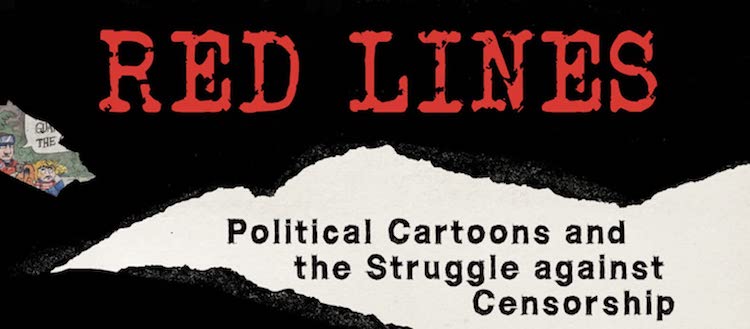
Written by Cherian George and designed by Sonny Liew, Red Lines: Political Cartoons and the Struggle against Censorship is a guide to the censorship of contemporary political cartoons around the world. The focus is on recent cases, though there are some historical examples of caricature and wartime propaganda. (Victor Navasky’s book The Art of Controversy has a more historical perspective.) Red Lines features cartoons subjected to lawsuits and bans, though it also covers cartoonists who have been harassed, sacked, deplatformed, arrested on trumped-up charges, or otherwise intimidated. The scope is truly global, and the cartoons under discussion are all reproduced, making this an extremely useful survey.
In terms of recent newspaper and magazine cartoons that have faced legal challenges, Red Lines covers all of the major cases though doesn’t include any unfamiliar ones. The examples it cites have all been previously mentioned on Dateline Bangkok: Zunar, Musa Kart (twice), Zapiro, LeMan, Stephff, Mana Neyestani, and Aseem Trivedi. The most explosive issue in political cartooning this century — the depiction of Mohammed — receives extensive coverage in Red Lines, and the twelve Jyllands-Posten cartoons are reproduced alongside others created in solidarity.
There are more than thirty pages devoted to the terrorist attack on the staff of Charlie Hebdo, and two of that newspaper’s Mohammed covers (from 2006 and 2011) are included, as is a tasteless 2013 cover mocking the Koran. My only criticism is that the events leading up to the 2015 attack are not fully explained: a timeline in the book juxtaposes the Koran cover and the attack, implying a direct connection, though they occurred more than a year apart. A more likely trigger for the attack — a 2014 cover depicting Mohammed being beheaded — is not mentioned.
In terms of recent newspaper and magazine cartoons that have faced legal challenges, Red Lines covers all of the major cases though doesn’t include any unfamiliar ones. The examples it cites have all been previously mentioned on Dateline Bangkok: Zunar, Musa Kart (twice), Zapiro, LeMan, Stephff, Mana Neyestani, and Aseem Trivedi. The most explosive issue in political cartooning this century — the depiction of Mohammed — receives extensive coverage in Red Lines, and the twelve Jyllands-Posten cartoons are reproduced alongside others created in solidarity.
There are more than thirty pages devoted to the terrorist attack on the staff of Charlie Hebdo, and two of that newspaper’s Mohammed covers (from 2006 and 2011) are included, as is a tasteless 2013 cover mocking the Koran. My only criticism is that the events leading up to the 2015 attack are not fully explained: a timeline in the book juxtaposes the Koran cover and the attack, implying a direct connection, though they occurred more than a year apart. A more likely trigger for the attack — a 2014 cover depicting Mohammed being beheaded — is not mentioned.


